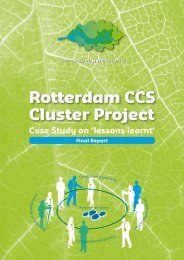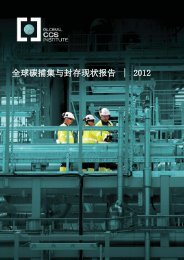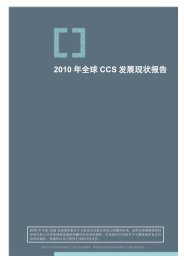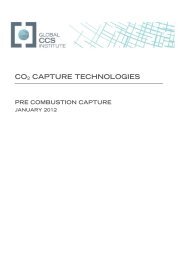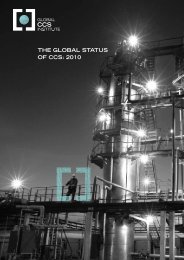Perceptions of CO2 Report - Global CCS Institute
Perceptions of CO2 Report - Global CCS Institute
Perceptions of CO2 Report - Global CCS Institute
- No tags were found...
You also want an ePaper? Increase the reach of your titles
YUMPU automatically turns print PDFs into web optimized ePapers that Google loves.
eceived information about natural phenomena involving CO 2 (e.g., the Lake Nyos incident)perceived CO 2 as more dangerous, but did not report that they had a more negative impression <strong>of</strong>it. Essentially, respondents who had no specific opinions on <strong>CCS</strong> initially moved towards a morepositive or negative opinion depending on the information provided. This highlights the importance<strong>of</strong> receiving reliable and balanced information in order to be able to form an opinion. It also meansthat people do not automatically become more positive about the technology if they know moreabout it or understand it better, but their opinions become more informed and more stable.Effects on <strong>CCS</strong> perceptionsMost respondents maintained the same opinion <strong>of</strong> <strong>CCS</strong> after the provision <strong>of</strong> information about it.Those who did change their opinions tended to perceive <strong>CCS</strong> as less positive, less clean, and lesssafe. Despite the fact that misperceptions <strong>of</strong> <strong>CCS</strong> relate to misperceptions <strong>of</strong> CO 2 , little changeoccurred in <strong>CCS</strong> perceptions when respondents were provided with information about CO₂’scharacteristics, natural phenomena relating to CO₂, CO₂ behaviour during <strong>CCS</strong>, or several <strong>of</strong> thesepieces <strong>of</strong> information. Three slight changes did occur:• Information on CO₂ characteristics (i.e., properties and chemistry) increased the perception <strong>of</strong><strong>CCS</strong> as a mature technology.• <strong>Perceptions</strong> <strong>of</strong> safety were damaged by information on CO 2 natural phenomena, particularly MtMammoth.• Information about the behaviour <strong>of</strong> CO 2 in <strong>CCS</strong> (particularly about induced seismicity)negatively influenced impressions <strong>of</strong> <strong>CCS</strong> as positive, clean (particularly related to the smallchance <strong>of</strong> CO 2 leakage), and safe (particularly related to topsoil acidification risk).In instances where changes in perceptions did occur, the type <strong>of</strong> knowledge presented led todifferent effects. For example, perceptions <strong>of</strong> <strong>CCS</strong> as ‘positive’, ‘clean’, ‘useful’ and ‘dangerous’were affected negatively and significantly by the provision <strong>of</strong> all sets <strong>of</strong> information. As anotherexample, informing participants <strong>of</strong> CO 2 ’s behaviour during <strong>CCS</strong> had mixed effects on perceptions(e.g., transport was viewed more positively, but earthquake risks were viewed more negatively);these effects may have cancelled each other out. This pattern demonstrates the importance <strong>of</strong>conveying complete and correct information on CO 2 ’s characteristics, as greater understandingcould mitigate issues that may arise when respondents receive incomplete information about <strong>CCS</strong>,such as by means <strong>of</strong> a single negative anecdote.Effects on attitudes towards implementationThe majority <strong>of</strong> respondents did not change their opinions on <strong>CCS</strong> implementation between thefirst and second assessment. The influence <strong>of</strong> respondents’ demographics was also somewhatconsistent between the two assessments. Respondents who had not changed their opinions werefound to have greater pre-existing knowledge <strong>of</strong> CO 2 ’s properties and characteristics; as such, theymay have tended to form their opinions based on their own knowledge and experience rather thanthe information that was provided to them as part <strong>of</strong> the survey. Respondents’ perceptionsregarding the risks and necessity <strong>of</strong> <strong>CCS</strong> were found to have the greatest influence on overallopinions on <strong>CCS</strong> implementation: the perception that <strong>CCS</strong> entailed too many risks to human healthhad a negative effect, while the belief that <strong>CCS</strong> is essential to mitigate climate change positivelyinfluenced opinions on <strong>CCS</strong> implementation.In general, the effects <strong>of</strong> information provision on respondent opinions <strong>of</strong> <strong>CCS</strong> implementationwere weak but consistent. It was noted that there was high collinearity among the covariatesbetween the pieces <strong>of</strong> information in package B (i.e., regarding Lake Nyos, Japanese hot springs,the paint factory incident, Mt. Mammoth, and natural CO 2 storage domes) and package C (i.e.,46 | Understanding how individuals perceive carbon dioxide




